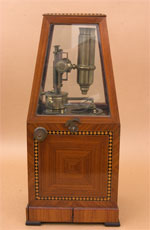 |
|||||
 |
 |
||||
 |
|||||
 |
 |
||||
Chiquet Box Microscope (No. 34) |
|||||||||
| Made: 1788 Made by: Jean-Baptiste Noel Chiquet Made in: France |
|||||||||
 |
|||||||||
 |
|||||||||
|
Chiquet Opticien
rue du haut moulin pres le pont N.D. paris 1788 |
|||||||||
 |
|||||||||
|
Jean-Baptiste Noel Chiquet (1722–c1794) was a highly regarded microscope maker in Paris in the late 18th Century. Prior to establishing his own shop, Chiquet worked for ten years with another highly skilled French instrument maker, George. Chiquet was awarded a certificate by the "Comité des Brevets" on June 13, 1789. The Comité was concerned with establishing patent rights for French "engineers" (inventors), and for awarding titles and patents. In July of that year he was given the title of Ingénieur de Roi (Engineer to the King); a title that was awarded to the most skilled craftsmen of the time. In 1791 Chiquet applied for a national award, but it wasn't until after his death when he received the award (dated 4 thermidor year II: 1794) of 5,000 livres (about $20,000) for his achievements in microscopy construction. With the exception of this instrument in the Golub Collection, no Chiquet microscopes were known to have survived to the present time*.
This microscope conforms to the French box style and that of Chiquet's mentor George. Daumas* describes a George microscope as having a stage consisting of balusters and cross-pieces. The George microscope was mounted on a "marquetry box containing an inclinable mirror...(with) the upper opening...closed by means of a rotating circular plate...(with) diaphragms of varying diameter." Both of these George microscope features also describe this Chiquet instrument. Given the similarity of this instrument to the description of Chiquet's mentor's microscopes, as well as the signature engraved on the body, and the document included with the instrument, it seems likely that this is an authentic Chiquet. This Chiquet compound microscope is mounted on a rosewood box with two front drawers and rosewood-framed glass top that may be fastened for storage. The front face of the box slides up to reveal the internal double-sided mirror. The microscope body is supported by a complex double-pillar support/focusing system mounted to a circular rotating base. The microscope body is mounted on a rotating frame that allows it to be positioned horizontally. There are two focusing mechanisms, a rack & pinion coarse adjustment and a screwthread fine adjust. The microscope has three lens systems visible (the body cannot be disassembled). It has a Ramsden eyepiece, a field lens and 10 removable objectives. Objective lenses are simple bi-convex optics. Samples are suspended between two horizontal bars, underneath which are curved springs. These are presumably for glass phials. The transmitted illuminating light is attenuated by a rotating aperture disc. The microscope assembly is 45cm tall, including the 22cm glass cover. Accessories include ivory and glass microscope slide specimens. Inside the mirror box were these two halves of a document dated 1788. *Daumas, M. 1972. Scientific instruments of the 17th and 18th centuries and their makers. Portman Books, London. Microscope featured 2/09 |
|||||||||